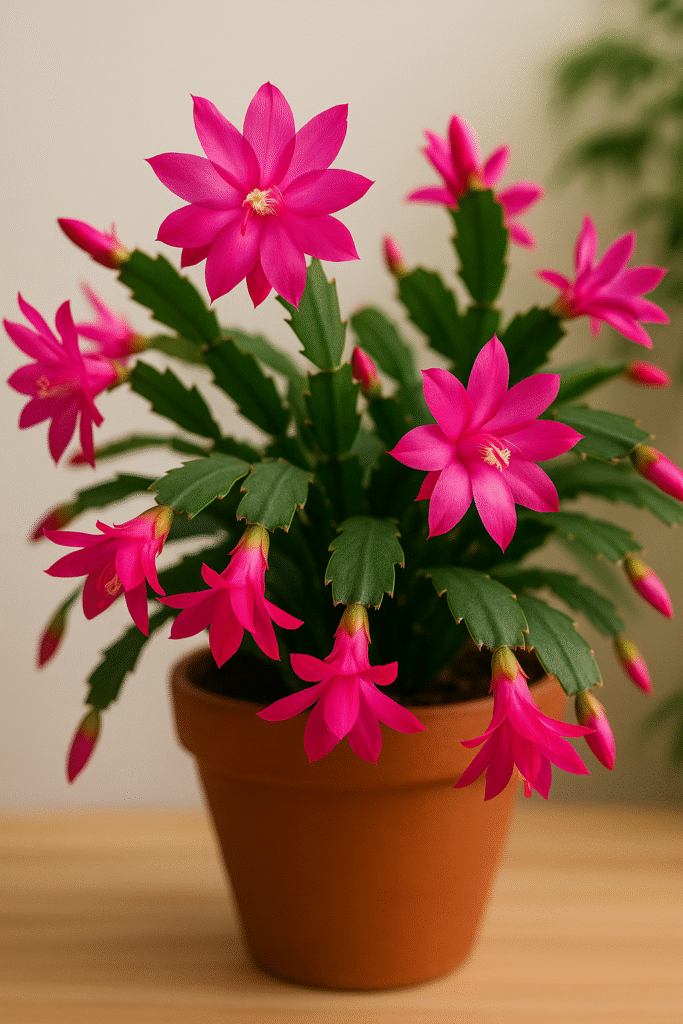The Christmas Cactus (Schlumbergera truncata), also known as Thanksgiving cactus or May flower, is a tropical plant native to Brazil’s Atlantic Forest. Beloved for its vibrant blooms and graceful arching stems, this plant brings color and elegance to homes—especially during the fall and winter months when most other plants are dormant.
In this article, you’ll discover everything you need to know to grow and care for the Christmas Cactus, from its origins and characteristics to expert tips for encouraging flowering. If you’re looking for a low-maintenance indoor plant that rewards you with spectacular blossoms, this is the one!
Origins and Natural Habitat
Despite being a cactus, the Christmas Cactus thrives in the cool, shaded forests of southeastern Brazil. It grows epiphytically on tree branches, absorbing moisture from the air and decaying leaves. Unlike desert cacti, it prefers humidity and diffused light.
Its common name varies depending on blooming time. In Brazil, it’s called “Flor-de-Maio” due to its flowering in May (autumn in the Southern Hemisphere), while in North America and Europe, it’s often associated with the holiday season.
Appearance and Growth
This cactus has segmented, flat green stems with serrated edges. The flowers bloom from the tip of each segment and come in a wide range of colors—magenta, red, pink, orange, yellow, and white. They have a tubular shape, opening into stunning star-like blossoms.
Each flower lasts several days, and since the plant blooms successively over weeks, it creates a prolonged display of beauty.
How to Care for a Christmas Cactus
Though it looks delicate, this cactus is hardy and thrives indoors. Follow these care tips for best results:
1. Light
Place in bright, indirect light. Avoid direct sun exposure, which can scorch its leaves.
2. Soil
Use a well-draining potting mix—ideally cactus soil mixed with peat and compost. You can also use orchid mix with added organic material.
3. Watering
Water when the top inch of soil is dry. Keep it slightly moist but never soggy. Reduce watering in late fall to trigger blooming.
4. Temperature
Ideal temperatures range between 60°F and 70°F (15–21°C). Cooler nights in autumn help initiate bud formation.
5. Fertilization
Feed monthly during spring and summer with a balanced liquid fertilizer. Stop fertilizing in the fall when buds begin forming.
6. Repotting and Pruning
Repot every 2–3 years in early spring. Trim after flowering to encourage bushier growth.
7. Propagation
Easily propagated by stem cuttings. Let the cut dry for 24 hours before planting in moist soil.
Blooming Season and Cycle
To ensure blooming, the plant needs shorter daylight periods and cooler temperatures. About six weeks of nights longer than 12 hours (without artificial light) is enough to initiate buds. If buds drop prematurely, it may be due to environmental stress or overwatering.
Common Problems
- Bud drop: Caused by sudden temperature changes or overwatering.
- Wilting segments: Indicate either underwatering or sunburn.
- Dark spots: Often a result of fungal infection from excess humidity.
Maintaining stable conditions and avoiding overwatering are key to keeping it healthy.
Fun Facts
- It’s not a desert cactus—it prefers moisture!
- Can live for decades and be passed down through generations.
- Often mistaken for the Thanksgiving or Easter cactus, which have slightly different leaf shapes and bloom times.
Final Thoughts
The Christmas Cactus is more than just a beautiful houseplant—it’s a tropical treasure that adds warmth and vibrance to any space. With minimal care, it rewards growers with a cascade of colorful blooms right when most gardens are quiet.
Whether you’re an experienced gardener or just starting out, the Christmas Cactus is a must-have for your indoor plant collection.
🌿 Perfect Planter for Your Christmas Cactus!
Give your plant the elegant home it deserves with the
Gepege 6 Inch Beaded Ceramic Planter Set – ideal for succulents, orchids, and flowering cacti like the Schlumbergera.
Stylish, durable, and comes with drainage and saucers!

Experience the rich aroma, unique flavor, and cultural tradition of Brazilian Basil — a treasured herb in kitchens across Brazil.
Learn More About Brazilian Basil

